Erica bolusiae var. cyathiformis
Erica bolusiae Salter var. cyathiformis H.A.Baker
Family: Ericaceae
Common names: Kraaifontein heath
Introduction
The Kraaifontein heath is Extinct in the Wild and could have become Extinct, had it not been for the actions of one individual. It is a variable and attractive species, exhibiting exquisite, tiny, light pink flowers in winter and spring. Unfortunately, the expansion of the suburbs of Cape Town, agriculture and grazing, combined with an alien acacia invasion, caused the complete loss of this taxon’s fynbos habitat near Kraaifontein on the Cape Flats, where it once flourished in seepage areas in the acidic soils of these sandy flats. Fortunately, it was saved from extinction by an Erica specialist, who prevented it from dying out in cultivation, during his internship in the Erica Garden at Kirstenbosch National Botanical Garden.
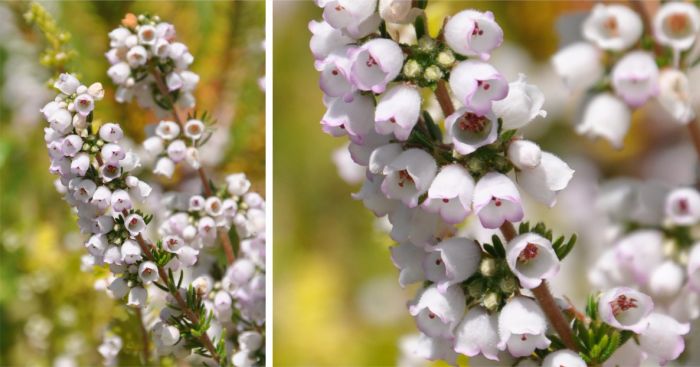
Description
Description
Erica bolusiae var. cyathiformis is a shrub which grows about 200 mm tall and 150 mm wide. It has long, soft branches which are hairy above, making them look shaggy. The leaves and petioles are 5–5.5 mm long combined, upright and imbricate when juvenile, spreading horizontally when mature, always longer than the internodes and covered with long, dense hairs. The inflorescences are in small umbels at the ends of branchlets, made up of 2 to 8 flowers, which are creamy white, sometimes flushed with pale pink. The corolla is slightly hairy and similar to that of Erica cyathiformis, 20–30 mm long, subglobose to campanulate or broad-urceolate to campanulate, either not constricted at the throat or hardly, and widened at the tip. This variety flowers from autumn to spring (March to October).

The typical variety is a spreading shrub, 300–500 mm tall, with hairless stems and branches pubescent in the upper part, leaves equal to or shorter than the internodes, white to bright pink, urn-shaped flowers with a pubescent corolla, about 4 mm long, borne in fours at the tips of branches in autumn and winter. The anthers are included and have awns.
Conservation Status
Status
Erica bolusiae var. cyathiformis is classified as Extinct in the Wild (EW) by the Red List of South African plants. This extinction was caused by the complete loss of its fynbos habitat near Kraaifontein on the Cape Flats, due to urban expansion, agriculture and grazing, combined with alien acacia invasion; it once flourished in seepage areas on the acid soils of these sandy flats. Fortunately, this variety had been propagated and cultivated at Kirstenbosch National Botanical Garden by Erica specialists, and as a result it survives in cultivation, and Kirstenbosch has been able to distribute plants to other professional growers and conservationists within South Africa.
The variety bolusiae, which occurs from Yzerfontein to Kraaifontein, is also threatened, and is assessed as Critically Endangered (CR). It is now known from just one location, of fewer than 250 mature individuals. The disappearance of its habitat is also caused by urbanisation, farming practices and invasive alien acacias.
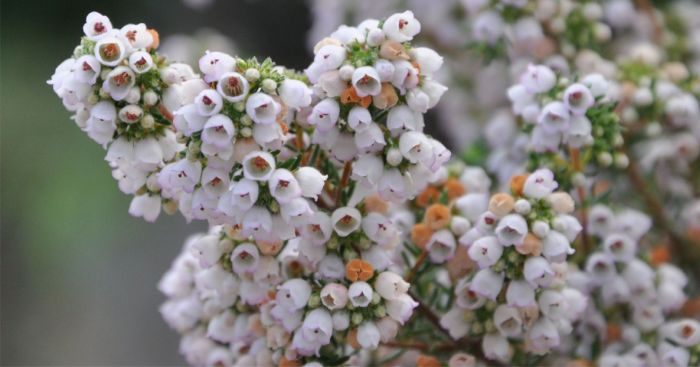
Distribution and habitat
Distribution description
Erica bolusiae var. cyathiformis grew in acid, sandy soils at low altitudes between 50–310 m on the Cape Flats. The plant is adapted to the typical Cape Flats weather, which is cool and wet in winter and hot, dry and windy during the summer months. The Kraaifontein heath is extinct in its natural habitat, it used to occur in Kraaifontein on the Durbanville Road, Belleville District, where it was endemic. The last surviving plants are cultivated specimens at Kirstenbosch National Botanical Garden. A restoration project will follow to make sure that the variety is returned to nearby, natural habitat, and that it is well-managed.
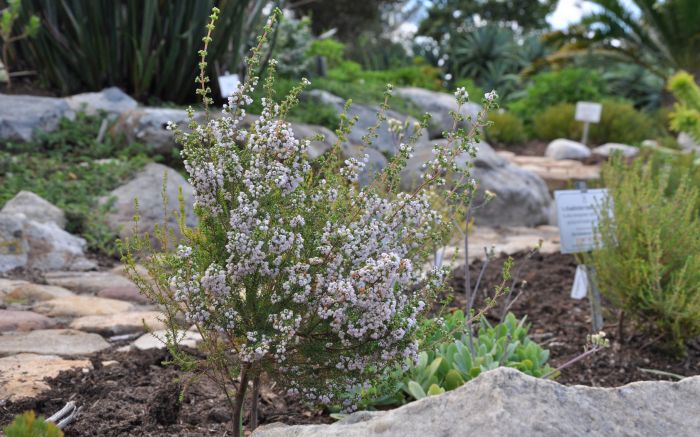
Derivation of name and historical aspects
History
The genus Erica is the largest of the genera in the Cape Floristic Region, with around 860 species. It occurs in Africa, Europe, and the Middle East, but the bulk of species are confined to the southern tip of Africa, where roughly 660 species occur in fynbos.
The genus name, Erica, comes from the Greek word ereiko, a name used for heather; it means ‘to break’, and possibly refers to the stems that are brittle and break easily. The species name bolusiae honors Harriet Margaret Louisa Bolus (1877–1970). Her great grand-uncle Harry Bolus appointed her as Curator of his private herbarium (now the Bolus Herbarium) in 1903, a post she held until her retirement in 1955 at the age of 77. In 1912 she married Frank Bolus, Harry’s youngest son, also a keen amateur botanist. She specialized in Ericaceae, Orchidaceae, Iridaceae and Mesembryanthemaceae. The varietal name cyathiformis, meaning ‘cup-shaped’, is derived from the Greek word cyathus meaning ‘a cup’ and the Latin formis, meaning ‘in the form of’.
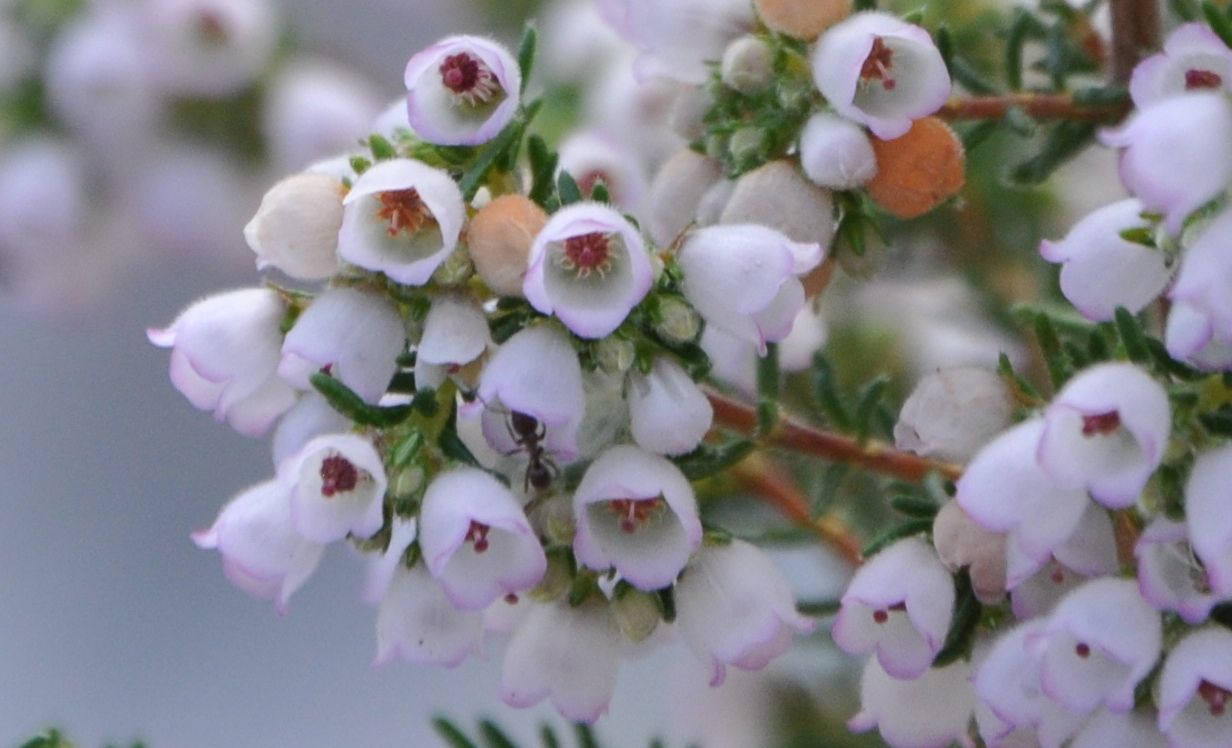
Ecology
Ecology
Given that Erica bolusiae var. cyathiformis is extinct in the wild, little is known of its ecology. At Kirstenbosch National Botanical Garden the flowers are visited by bees as well as other insects, one of which may be the plant’s pollinator.
Uses
Use
Erica bolusiae var. cyathiformis is not used in traditional medicine, nor is it one of the species commonly cultivated or sold as a cut-flower, not because it does not last well in the vase, which it does, but because its stems are not long enough. It has the potential to be an attractive garden ornamental and does well as a pot plant.
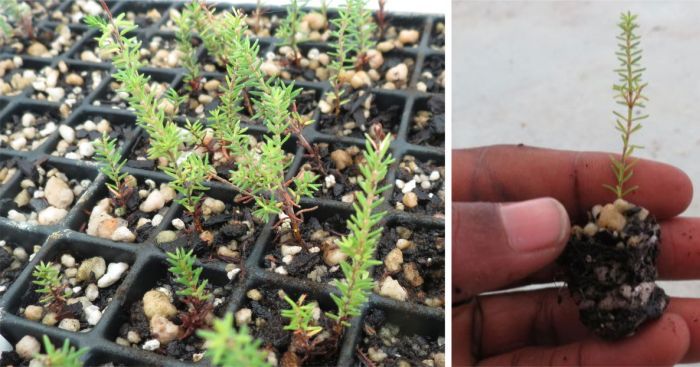
Growing Erica bolusiae var. cyathiformis
Grow
To grow Erica bolusiae var. cyathiformis, you need a well-ventilated, sunny position, in well-drained, sandy, acidic soil. Feed with well-rotted compost applied as a mulch once or twice a year. Dilute or low doses of slow-release fertilizer can also be used. Pinching the tips on young plants results in a plant that is more branched, more compact and more floriferous. It is also suitable for containers.
To root Erica bolusiae var. cyathiformis, take semi-hardwood tip or heel cuttings in late summer to autumn, or in spring. Treat with rooting hormone and place in well-drained, well-aerated, sterile rooting medium. A root-stimulating hormone, such as auxin powder or IBA, is used to propagate 50–70 mm long cuttings. Visible flower parts are removed, and cuttings dipped in a solution of seaweed extract and watered before propagation. The cuttings are placed in a medium suitable for fynbos (such as a mixture of fine-milled bark and perlite). The excess powder is allowed to stay on the cutting, where it is placed in the moist medium, by first making a thin hole with a sterile wire and then placing the cutting in the hole. The tray with cuttings is labelled and then placed in the propagation mist house.
The mist house has a temperature of 25(±2)°C, and it sprays water every 15 minutes for 5 seconds, to keep the rooting medium moist, the leaves cool and moist, while the beds are heated and kept at a warm temperature of 22–25°C. The cuttings root after 2–3 months, are hardened off for a week in a shady area and then potted into 2 kg nursery bags, using a fynbos soil mix. They are watered regularly and given organic fertilizers once a month for increased growth and planted into the garden when ready. Erica bolusiae var. cyathiformis needs a sunny position with free air circulation, in sandy, acidic soil. It is ideal for fynbos gardens, especially those on the sandy flats.
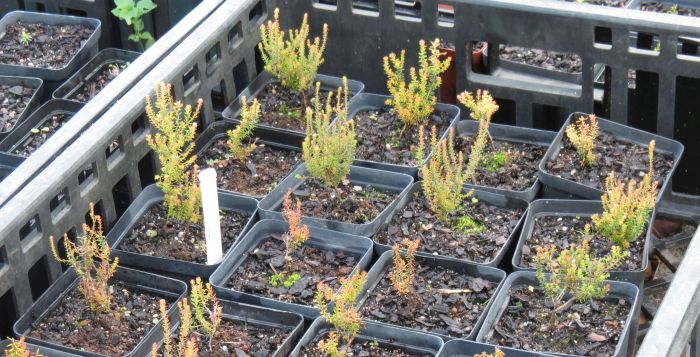
Erica bolusiae var. cyathiformis is currently grown at Kirstenbosch NBG, being propagated there by Caylot Zide (former Kirstenbosch staff member and current Erica Garden volunteer) and Kamogelo Solomon Modimola (MSc Candidate: Kirstenbosch NBG & UCT). The original plants of Erica bolusiae var. cyathiformis were collected from the wild in 1984, and then planted in the garden at Kirstenbosch. Unfortunately, the last two mother plants died during the COVID-19 Lockdown of 2020. However, in a stroke of luck for the variety, by chance, Kamogelo had chosen to propagate Erica bolusiae var. cyathiformis before the lockdown, selecting it from the many threatened ericas grown at Kirstenbosch and listed on the Threatened Plants Species List and unknowingly saved the plant from extinction. Early in 2020 cuttings were placed in the propagation mist unit in the collections nursery, until rooting occurred. By February 2020, 48 cuttings had rooted, and they were potted into plug units using the Kirstenbosch Nursery Fynbos mix and then treated with seaweed extract monthly, while being watered every third day. Thankfully, they survived the lockdown in 2020.
The best conservation horticulture tip Kamogelo was given about ericas, from both Anthony Hitchcock (former SANBI Erica Specialist) and Zide was: ‘Always know your threatened species very well and there must always be more than 10 mother plants, and for back-up there must also always be young plantlets in the nursery (either from seeds or cuttings), with a tray of cuttings propagated and with potted plants grown for display in the garden’. To Kamogelo, these two men were exigent and demanded all his effort for only the ericas. However, their teaching and Kamogelo’s work in the Erica Garden and collecting in the field with MSBP to bring back species for Zide to expand and maintain the species in the Erica Collection is now paying off. Kamogelo, with the help of Zide, has also propagated several other threatened species of Erica, such as E. verticillata, E. turgida, E. amoena, E. retorta, E. shannonii, E. brachialis and E. haematocodon. Once again, the benefit of keeping threatened plant species in cultivation and promoting the horticulture of these species has paid off with Kamogelo, under the instruction and words of both Anthony and Zide, having avoided a very close call for a very endangered plant.
References
- Baker, H. A. 1956. Notes on some species of Erica, with descriptions of three new species and two new varieties. Journal of South African Botany 31: 159.
- Goldblatt, P. & Manning, J. 2000. Cape Plants. A conspectus of the Cape flora of South Africa. Strelitzia 9. National Botanical Institute, Pretoria & Missouri Botanical Garden, Missouri.
- Salter, T.M. 1935. Plantae Novae Africanae. Journal of South African Botany 1: 125–126.
- Schumann, D., Kirsten, G. & Oliver, E.G.H. 1992. Ericas of South Africa. Fernwood Press, Vlaeberg.
- Turner, R.C. & Raimondo, D. 2006. Erica bolusiae Salter var. bolusiae. National Assessment: Red List of South African Plants version 2020.1. Accessed on 2021/08/24.
- Turner, R.C. & Raimondo, D. 2006. Erica bolusiae Salter var. cyathiformis H.A.Baker. National Assessment: Red List of South African Plants version 2020.1. Accessed on 2021/07/13.
Credits
Kamogelo Solomon Modimola (MSc Candidate: Kirstenbosch NBG & UCT) & Robert Blackhall-Miles (Author of Fossil Plants)
Kirstenbosch National Botanical Garden
September 2021
Acknowledgements: the authors thank Anthony Hitchcock (may his soul rest in peace), Victoria Wilman and Caylot Zide for their horticultural tips and sharing their knowledge of ericas; Alex Lansdowne and Rupert Koopman who highlighted the plight of this plant as part of the Global Conservation Consortium for Erica; Cherise Viljoen and Mashudu Nndanduleni for their continuous support; Alice Notten for providing the images of Erica bolusiae var. cyathiformis in flower; and finally Mrs. Erica (Siqamo Yeko) for her continuous support and help in every species she could, her love for these species made me want to conserve as much as I could.
Plant Attributes:
Plant Type: Shrub
SA Distribution: Western Cape
Soil type: Sandy
Flowering season: Spring, Autumn, Winter
PH: Acid
Flower colour: Pink, Cream
Aspect: Full Sun
Gardening skill: Average
Special Features:
Horticultural zones







Rate this article
Article well written and informative
Rate this plant
Is this an interesting plant?
Login to add your Comment
Back to topNot registered yet? Click here to register.